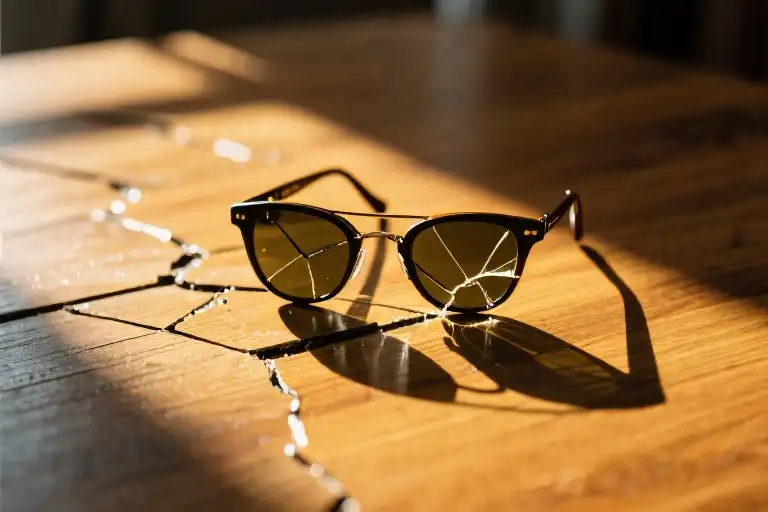The image still burns behind my eyelids—fifteen young men and women walking single file into the chapel, their collective weight bending the air around them. They moved like a single organism, shoulders touching, hands occasionally brushing against each other for grounding. No one spoke. No one needed to. The silence between them was louder than any words could have been. I sat there clutching the program, its edges digging into my palm, realizing this loss had cracked me open in ways I hadn’t expected. Because grief doesn’t stack neatly in chronological order or separate itself by person. It spills. One loss becomes all losses.
My fingers traced the photo on the memorial card—my cousin at two years old, grinning in a denim overall with a popsicle smeared across his face. The same photo sat in my mother’s album back home. Suddenly I was fifteen again, holding this squirming toddler who’d just discovered the joy of sticking his fingers in cake frosting. The memory arrived uninvited, dragging with it all the others: my mother’s laughter at that same birthday party, my best friend Heather stealing a bite of the ruined cake when she thought no one was looking. The present loss had become a doorway, and through it marched every person I’d ever mourned.
There’s a particular cruelty to grief’s timing. Just when you think you’ve compartmentalized one sorrow, another loss comes along and shakes the entire structure. The body remembers what the mind tries to archive. That morning before the service, I’d stood under a scalding shower until the bathroom mirror fogged over, trying to wash away the tension coiling between my shoulder blades. It didn’t work. My muscles held onto the strain like they were afraid to let go. Later, when my aunt pulled me into a hug, I felt her trembling—not the surface shiver of cold, but something deeper, as if her skeleton was vibrating beneath her skin. We both knew this dance well enough to keep our tears silent. The program listed his cause of death as “sudden accident,” those two words carrying more devastation than the entire page of condolences beneath them.
What surprised me wasn’t the sadness, but its shape. It didn’t arrive as a single blade piercing cleanly through. It came as a flood, murky and full of debris—carrying fragments of my mother’s last days, the sound of my grandfather’s oxygen machine, the way Heather’s perfume lingered on her scarf for weeks after she was gone. Modern grief etiquette expects tidy packages: one year per person, neatly labeled and stored on separate shelves. But the heart doesn’t catalog that way. A song, a scent, the way light falls through a window at a certain angle—any of these can topple the entire system.
That evening, after most guests had left, I found myself sitting on my aunt’s porch with the three sisters—my mother’s siblings. The cicadas were loud enough to drown out the occasional sob from inside the house. Someone brought out sweet tea in the same jelly jar glasses we’d used at family reunions twenty years prior. When one aunt remarked how my sarcastic comment sounded “just like your mom,” the recognition landed like both a gift and a gut punch. The conversation spiraled into stories about their childhood, their voices layering over each other in familiar rhythms. For a moment, the years collapsed. I wasn’t just mourning my cousin; I was grieving every version of us that would never sit together like this again. The realization tasted metallic, like biting down on aluminum foil.
Grief reshapes your internal landscape long after the external rituals conclude. A week later, back in my apartment, I woke with my jaw clenched so tight it ached. The medical journals weren’t exaggerating—studies from Johns Hopkins confirm that bereavement triggers measurable physiological stress responses, from increased inflammation markers to altered heart rate variability. My body was keeping score even when my mind wasn’t. That invisible weight pressing on my sternum? Harvard researchers could probably trace it to the norepinephrine flooding my system. The lump in my throat that made swallowing difficult? The Mayo Clinic would nod understandingly at that classic grief response. Knowing these symptoms had names didn’t make them easier to bear, but it did make me feel less alone in them.
What stays with me most isn’t the sorrow, but the love that refused to be contained by it. Those fifteen friends who filled the front pew didn’t come to perform perfect composure. They came because their presence was the only language adequate for that moment. In the end, that’s all any of us can do—show up, spill over, and trust that the mess is part of the meaning.
When New Pain Awakens the Old: How Grief Multiplies
The blue baby outfit in the memorial slideshow shouldn’t have surprised me. I’d seen that same photograph a hundred times in my grandmother’s house – my cousin’s bright blonde curls framing his round cheeks, tiny fingers grasping at the camera. But when it flashed on the screen between hymns and eulogies, my breath caught like I’d been punched. That outfit. My mother had bought it for him. She’d held him in it, cooing the same way she’d held me years before. And just like that, I wasn’t just mourning a 24-year-old taken too soon; I was back in pediatric ICU watching nurses disconnect my mother’s ventilator.
Grief doesn’t respect timelines or categories. It certainly doesn’t ask permission before dragging every unresolved loss you’ve ever carried into the present moment. What began as sorrow for my cousin became a tidal wave that pulled my mother’s death from 2012, my best friend’s overdose in 2018, even my grandfather’s slow fade from Alzheimer’s back in 2009 into its undertow. The human heart keeps no orderly filing system for pain. One fresh loss can make the scar tissue of every previous bereavement split open anew.
There’s a particular cruelty to how memory works in mourning. The brain resurrects sensations you’d forgotten your body could recall: the sterile smell of hospital corridors, the weight of a headstone rubbing against your palm during visitation, the exact timbre of a voice now silenced. At the funeral luncheon, someone served red velvet cake – my mother’s favorite. The cream cheese frosting triggered a visceral memory of her licking the mixing bowl clean during my tenth birthday party. For three seconds, I could taste the batter and hear her laughter before reality snapped back. These involuntary time travels leave you stranded between past and present, unable to fully inhabit either.
Multiple losses compound in ways that defy simple arithmetic. It’s not that you grieve each person separately; their absences begin conversing with one another in your psyche. My cousin’s unfinished life whispered to my best friend’s addiction struggles. My mother’s missed milestones echoed through my grandfather’s empty recliner. The connections between them – some logical, others inexplicable – formed a web where tugging one thread made the entire structure tremble.
What surprised me most wasn’t the returning pain, but its transformed nature. The sharp edges of recent grief had softened over years, only to return now with a different quality – less like a knife and more like a deep bruise that still aches when pressed. Time hadn’t erased these sorrows; it had layered them into my bones. Now they pulsed in unison, a discordant symphony of absence.
Perhaps this is why we instinctively avoid revisiting old grief. Not because we’ve “moved on” in any real sense, but because we fear awakening dormant pain that might prove stronger than our current coping mechanisms. Yet there’s an unexpected gift in this involuntary remembrance: the realization that love, even lost love, remains metabolically active within us. These resurfacing sorrows confirm what we most need to believe – that those we’ve loved haven’t truly left us, not completely, not while we still carry the capacity to miss them.
In the days after the funeral, I found myself doing something peculiar. I began speaking to my mother aloud while driving, updating her on family news she’d never hear. I dug out Heather’s last text message and finally replied, three years too late. I visited my grandfather’s favorite fishing spot and threw in a handful of the pebbles we’d once used as sinkers. These weren’t conscious decisions so much as organic responses to grief’s spillover effect. When fresh loss cracks you open, all your love – past and present – comes rushing out seeking somewhere new to land.
The Body Remembers: When Grief Moves In
I noticed it first in my shoulders—a tension so deep it felt like my muscles had turned to stone. Then came the lump in my throat, that persistent swelling just below my Adam’s apple where words go to die. By the third night, exhaustion pinned me to the bed while my mind raced through memories like a film reel on fast-forward. This wasn’t just sadness. My body had become a living archive of loss.
Grief never stays confined to the emotional realm. It migrates. After my cousin’s funeral, I became acutely aware of how physical mourning can be—the way it rewires your nervous system, alters your breathing patterns, even changes how food tastes. Research from Mayo Clinic explains why: intense grief activates the same stress response as facing a physical threat. Cortisol floods your bloodstream, adrenaline keeps your muscles primed for danger, and suddenly you’re carrying what feels like an invisible boulder 24/7.
That heaviness isn’t metaphorical. A Harvard Health study found your risk of heart attack spikes twenty-onefold in the first day after losing someone. The National Library of Medicine links prolonged, unprocessed grief to chronic inflammation and compromised immunity. When people say “broken heart syndrome,” they’re not being poetic—they’re describing takotsubo cardiomyopathy, an actual condition where grief-stricken hearts temporarily weaken and change shape.
My aunt embodied this physically. At the funeral home, I watched her fingers tremble around a water glass, her normally steady hands betraying the seismic shift inside. She’d lost her youngest child, and her body was keeping score—the slight tremor in her left eyelid, the way she kept pressing two fingers to her sternum as if holding herself together. We inherit so much from our families, including how we grieve. In our case: silently, with occasional bursts of laughter that startle even ourselves.
Western medicine tends to treat these symptoms in isolation—sleep aids for insomnia, muscle relaxants for tension, antacids for the stomachaches grief often brings. But traditional healing systems recognize what we’ve forgotten: mourning requires physical release. The Maori practice of haka, Jewish shiva’s seven days of communal weeping, even the Irish wake’s raucous storytelling—these rituals create space for the body to process what the mind can’t contain.
Three weeks after the funeral, I woke to find my jaw aching from nights of clenched teeth. My physiotherapist traced her fingers along my trapezius muscles and sighed. “Grief armor,” she called it—the way we unconsciously brace against pain until our bodies fossilize into protective postures. Her recommendation surprised me: scream into pillows. Take up kickboxing. Let my limbs express what my voice couldn’t. “Tears are just your body sweating out sorrow,” she said, handing me a list of local bereavement yoga classes.
We catalog emotional wounds so carefully—the dates, the last words, the what-ifs—but rarely acknowledge how loss rewrites our cellular blueprint. That persistent cough since Dad died? The lower back pain that arrived with Mom’s cancer diagnosis? Your body’s memory is more faithful than your conscious mind. It remembers the exact weight of the phone in your hand when you got the news, the way the air smelled in the hospital corridor, the particular slant of afternoon light during your last normal conversation.
Healing begins when we stop treating grief as purely psychological. What if we massaged sore shoulders with the same reverence we bring to memorial services? If we recognized insomnia as part of the mourning process rather than a sleep disorder to medicate away? My cousin’s death taught me this: mourning isn’t complete until it’s embodied. However you need to move, shake, scream, or collapse—let your body lead the way home.
The Silence Around Death: Why We Bury Our Grief
The chapel pews creaked as my cousin shifted beside me, his entire body vibrating with something raw and primal. His hands clenched the funeral program until the paper wrinkled, yet his face remained still as marble. I recognized that tension – the physical manifestation of grief straining against the invisible cage of propriety. We sat shoulder to shoulder in that stifling Southern heat, collectively holding our breath against the emotional tsunami threatening to drown us all.
Western culture has perfected the art of grieving politely. We whisper about death in hospital corridors and funeral parlors, our sentences trailing off into awkward pauses. We say “passed away” instead of “died,” as if linguistic softening could cushion the blow. At my cousin’s service, the loudest sounds were the muffled sniffling into tissues and the occasional strained chuckle during eulogies. The real anguish – the body-wracking sobs, the guttural cries – those happened later, behind closed doors where no one would feel compelled to offer uncomfortable platitudes.
This cultural script feels particularly cruel when contrasted with mourning traditions elsewhere. In Ghana, funeral processions burst with color and sound – professional wailers lead the way while mourners dance wearing elaborate red and black garments. The Akan people believe loud lamentations help guide the deceased’s spirit to the afterlife. Jewish shiva practices create structured space for grief, where visitors literally sit with sorrow for seven days without expectation of cheerful small talk. Middle Eastern keening traditions involve rhythmic crying and chest-beating, giving physical form to emotional pain rather than locking it away.
Research from the Center for Loss & Life Transition confirms what these cultures have known for centuries: suppressed grief doesn’t disappear. It migrates. It settles in our muscles as chronic tension, our digestive systems as unexplained nausea, our nervous systems as heightened startle responses. Dr. Alan Wolfelt’s studies show communities with formalized mourning rituals report lower rates of complicated grief disorders. Yet we persist in our stiff-upper-lip approach, treating emotional outbursts at funerals like social faux pas rather than necessary releases.
That funeral home air conditioning couldn’t mask the scent of sweat and suppressed tears. I watched my aunt – my cousin’s mother – accept condolences with gracious nods, her spine straight as a ruler. Only someone who knew her well would notice the slight tremor in her coffee cup, the way her left eyelid twitched when someone mentioned his baseball trophies. We’ve been conditioned to believe this is strength. That composure equals coping. But when I finally heard her wail alone in her pantry later that night, it sounded more like truth than anything that happened during the “official” mourning.
Perhaps we fear that unleashing grief will make it infinite. That if we start crying, we’ll never stop. But the opposite proves true – ritualized expression creates containers for the uncontainable. When Tibetan Buddhists perform sky burials, when Irish wake-goers tell raucous stories about the deceased, when Mexican families picnic at graves during Día de Muertos, they’re not avoiding pain. They’re meeting it head-on with community armor. Their traditions acknowledge what ours often deny: grief needs witness. Sorrow requires space. And mourning demands sound.
Back home in Tennessee, I found myself screaming into my steering wheel on lonely backroads. Not just for my cousin, but for every loss I’d ever swallowed down with polite thank-yous and tight-lipped smiles. The sound startled me at first – this animal noise coming from my civilized body. But afterward, my shoulders dropped two inches. That lump in my throat shrank just enough to let me breathe. Maybe our cultural fear of messy grief creates more suffering than the grief itself. Maybe healing begins when we stop whispering about death and start shouting our love for the departed – in whatever raw, imperfect, human way we can.
Letting Grief Flow: Three Ways to Honor Your Loss
The weight of grief can feel like carrying a stone in your chest – dense, unyielding, and impossible to ignore. After my cousin’s funeral, I realized something crucial: grief demands movement. It’s not meant to be stored away in some quiet corner of your heart. Like water, it needs channels to flow through, spaces to fill, ways to reach the light. Here are three practices that helped me – and might help you – begin that necessary journey.
Speak Their Name Aloud
We whisper about death as if it’s contagious. At the memorial service, I noticed how people lowered their voices when mentioning how he died, as though saying the words might summon fresh pain. But silence doesn’t protect us – it isolates. I’ve started setting a place for my mom at Sunday dinners. Not physically, but by sharing a story about her while we eat. ‘Remember when mom tried to make Thanksgiving turkey in July?’ These moments stitch their presence into our ongoing lives.
Research from the Grief Recovery Institute shows that verbalizing memories activates different neural pathways than silent recollection. When we say their name, we’re not just remembering – we’re reaffirming that their life mattered enough to disrupt the quiet. Start small: tell the barista about your friend’s ridiculous coffee order, mention your grandfather’s favorite book to the librarian. Let their essence ripple outward.
Create Simple Rituals
Modern life offers few containers for grief. Unlike the Jewish tradition of sitting shiva or Ghana’s celebratory mourning dances, we’re left scrambling for ways to express what words can’t hold. After the funeral, I planted camellias – my cousin’s favorite – along my porch. Each bloom reminds me that grief and beauty can coexist.
Rituals don’t require elaborate planning. Light a candle on birthdays. Cook their signature dish annually. Keep a notebook by your bed for ‘letters’ to them. A study in the Journal of Death and Dying found that participants who engaged in regular mourning rituals reported 30% lower stress hormone levels. The act itself matters less than the intentionality behind it – creating space where sorrow can breathe.
Find Your People
Grief reshapes your social landscape. Some relationships fade while others deepen unexpectedly. At the funeral, I met my cousin’s college roommate who’d also lost a sibling. We didn’t need to explain anything – that bone-deep understanding was immediate.
Look for those who can hold space without fixing: bereavement groups (many now virtual), online communities like The Dinner Party for younger grievers, or even a therapist specializing in loss. The Center for Prolonged Grief reports that communal mourning reduces feelings of isolation by up to 60%. You need witnesses to your pain – people who won’t flinch when the mask slips.
These practices won’t erase the hurt. Nothing does. But they can help transform grief from something you carry to something that moves through you. The love remains; the pain finds pathways. Start with one small act today – say their name, light a candle, text someone who gets it. However you choose to begin, remember: grief only stays heavy when it has nowhere to go.
When Love Has Nowhere to Go
The heaviest grief I’ve ever carried wasn’t the weight of a single loss, but the unbearable lightness of love with no destination. That’s the cruel paradox no one prepares you for – how the love you once poured so freely into someone becomes this restless energy circling your ribcage, searching for a familiar heartbeat that no longer answers.
At my cousin’s memorial, I watched his mother press her palm against the polished wood of his casket, her shoulders moving in silent tremors rather than the wails her body clearly wanted to release. We’ve perfected this art of contained mourning in the West, treating grief like an inconvenient spill to be quickly mopped up before it stains the furniture. But grief isn’t a mess – it’s the last conversation your love keeps trying to have.
The body knows what the mind resists
Three days after the service, I woke with my jaw clenched so tight I could barely sip coffee. My trapezius muscles had turned to stone, as if my shoulders were trying to ear themselves against some invisible blow. This wasn’t metaphor – it was physiology. The 21-fold increase in heart attack risk during bereavement that Harvard researchers identified? It lives in the tension between your scapulae. The insomnia studies from Mayo Clinic? You’ll find them in the purple shadows beneath your eyes at 3 AM when you’re bargaining with a universe that took your person.
We pathologize these reactions when they’re actually the most rational response to irrational loss. That lump in your throat when you try to say their name? It’s not weakness – it’s your vocal cords rebelling against the lie that everything’s fine. The way your hands shake when you pass their favorite diner? That’s just your nervous system being more honest than your social self knows how to be.
The courage of falling apart
Jewish tradition teaches that when mourners rend their garments at a funeral, the tear should be made over the heart – visible, irreversible, a public acknowledgment that some damage can’t be neatly repaired. There’s radical permission in that ritual we’ve forgotten: the right to let your outside match your insides.
I used to think strength meant being the composed one at funerals, the steady hand holding others up. Now I know it takes far more courage to be the person who wails until their voice breaks, who lets snot and tears mix on their face without wiping them away, who says “This fucking hurts” instead of “I’m fine.” Real mourning isn’t presentable. It’s messy as a newborn, urgent as a hemorrhage, true as a fracture.
Your turn
So here’s what I need you to do tonight, while the house is quiet and no one’s watching:
- Say their name out loud to the empty room. Let it echo. Notice how the syllables feel in your mouth after weeks of swallowing them.
- Find one object they touched – a coffee mug, a book, that ridiculous souvenir from the road trip – and hold it until your palms remember the weight of them.
- Make a sound you’ve been silencing. It might come out as a sob, a laugh, or a scream that startles the dog. All versions are holy.
This isn’t indulgence. It’s the work your love demands now that its recipient is gone. Every tear is proof you knew how to love deeply in a world that often skims the surface. Every tremor is evidence you dared to attach in a culture that fetishizes detachment.
Grief isn’t the absence of strength – it’s the presence of love that refuses to pretend. So let it wreck you. Let it remake you. Let it be the most honest thing you’ve ever done.





